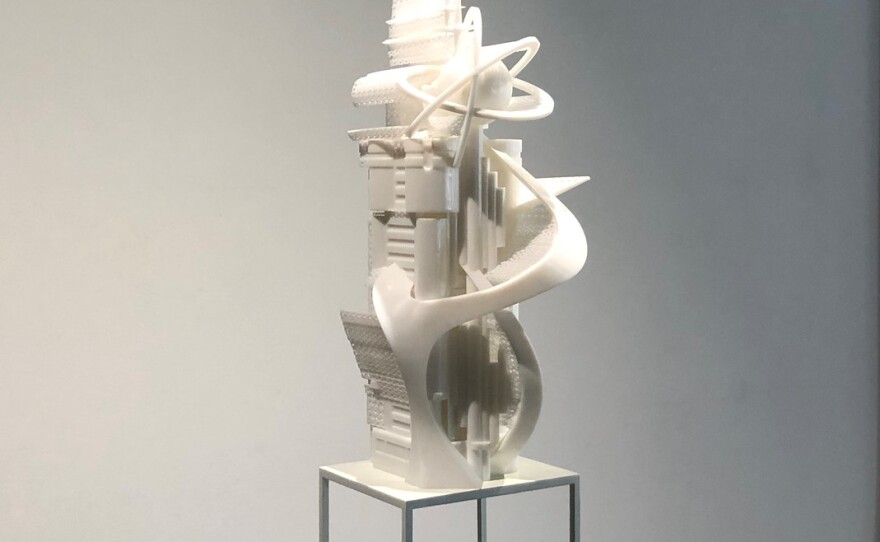This summer, artists from around the world are exhibiting their work throughout Northeast Ohio as part of the FRONT International Triennial. On this week’s State of the Arts, WKSU's Mark Arehart heads to an Allen Memorial Art Museum gallery in Oberlin to take in one artist's fantastical view of architecture around her home country of China.
As I entered the Richard D. Baron '64 Art Gallery in downtown Oberlin, I was instantly struck by Artist Cui Jie's oil paintings.
They feature sweeping, geometric shapes swimming around what seem to be ordinary concrete office towers or high rises. They look almost like something out of The Jetsons.
Allen Memorial Art Museum Assistant Curator Andrea Gyorody drew me in close to one canvas.
"They look flat from a distance, but when visitors come, I hope they get close up. Because they are thickly impastoed and have a lot of sculptural presence that is surprising," Gyorody said.
Building a Foundation
Cui Jie’s was born in the 1980s, a post-Mao era that’s described as more globally conscious, with architectural influences to match.
But it’s clear that the architecture in the center of her artwork was about more than just buildings. It looked like nothing that’s ever been constructed in reality.
"They do have this vibe of a kind of outmoded futurism. And I think that is something the artist is interested in is the sense of when you’re constructing very futuristic architecture it’s almost outdated or outmoded almost instantaneously," Gyorody said.

There's a sense of an almost tug-of-war between what the artist saw and what she imagined.
"And she is combining in these paintings both these very futuristic buildings that have cropped up over the last 30 or so years in China with these kind of nondescript slab buildings which were built prior to that in the '80s and '90s," Gyorody said.
There are a series of spiraling lines flowing through several paintings that give a feeling of whizzing by at incredible speed.
"Which I think forces you to think about how architecture and movement are not necessarily opposed, but aligned in the sense of a culture moving forward and backward in time, and one moving in and around buildings," Gyorody said.
Bonnie Cheng, Oberlin's Associate Professor of Art History and East Asian Studies, joined us as we walked between Cui Jie’s paintings and colored pencil sketches.
"There was a big building campaign called the 10 great buildings in 1959 that was sort of an anniversary construction after the founding of the People’s Republic of China in ’49. And they built 10 buildings. They had three different styles, the Soviet Style, International Style, and the sort of hybrid Chinese style," Cheng said.

Through the Artist's Eyes
A crash course in Chinese architecture won't be found here. This exhibition was all about what the artist saw.
"Cui Jie is also mobile so she was born in Shanghai, educated in Hangzhou and lives in Beijing. So these are the three cities that she draws from," Cheng said.

The exhibition also housed 3D-printed adaptations of Cui Jie’s fantastical buildings. They challenged the viewer to leave expectations at the door.
"And I think Cui’s work tries to collapse time and space in a way that, if you’re an attentive viewer, forces you to think about what your presumptions have been about Chinese metropolises and a global China and to test them against a Chinese artist is seeing when she walks through those spaces," Gyorody said.
How to See It
The exhibition was Cui Jie's first solo show in the United States. It is on display through September 30 in Oberlin as part of the FRONT International Triennial.
The Allen Memorial Art Museum is hosting two additional architecture-themed shows as part of FRONT by artists Barbara Bloom and Juan Araujo.








